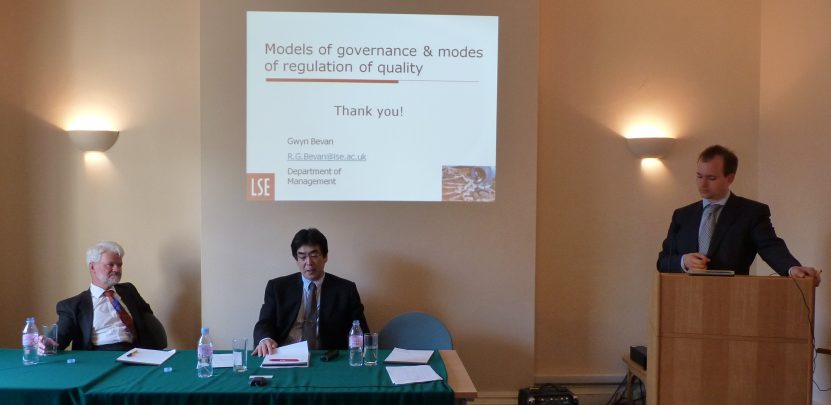 Seminar Series 2011
Seminar Series 2011Tuesday 14 June 2011
6:00pm – 7:45pm
Healthcare Provision and Management in the UK and Japan
Drinks reception from 8:45pm
Daiwa Foundation Japan House
Organised by the Daiwa Anglo-Japanese Foundation
This fifth seminar in the 2011 series, Uncertain Futures: The Individual, Society and the State in the UK and Japan, considered the issues surrounding healthcare provision and management in theUK andJapan. This is a highly topical area for debate in theUK as spending cuts and healthcare reforms focus attention on the ways in which the NHS must adapt to changing times. The Japanese health service is facing similar difficulties asJapan’s ageing population and low birth rate impact upon healthcare needs and provision. Our speakers brought both academic and professional perspectives to bear on this comparative discussion of the economics and social dynamics of healthcare provision.
The first speaker, Kiyoshi Morita, gave an overview of the Japanese healthcare system, spoke about its impending challenges and future prospects and shed light on the 11 March earthquake’s subsequent impact on healthcare inJapan. He began by comparing the English and Japanese approaches to healthcare, both of which he showed to be universal and comprehensive and able to keep expenses comparatively low.
The Japanese universal healthcare system, established in 1961, is funded by the social insurance system, the British National Health System (NHS) is financed by tax, while in theUSAthere is no universal healthcare provision at all said Morita.
70% of all hospital beds inJapanare occupied while inEnglandthis figure rises to 100% occupancy. Whereas inJapanindividuals have free access to any clinic or hospital, inEnglandindividuals are referred to a hospital by a General Practitioner (GP). Compared to other developed countries such asGermany,France,Englandand theUSA,Japanhas the lowest infant mortality rate (2.6 per 1000 births), the lowest pre-term mortality rate and longest life expectancy.
The current state of the Japanese healthcare delivery system, said Morita, is advanced and makes use of expensive technology. Consequently, it requires massive funding and is a major financial burden on the government. It is completely patient based, results in long hospital stays for elderly patients and suffers from poor government funding, insufficient medical workforce and an increasing workload on all medical personnel.
The challenges and future prospects of the Japanese healthcare system encompass the ageing society and declining birthrate, the exhaustion of existing resources, inadequate delivery of proper healthcare and the 11 March earthquake. In 2005, Morita noted, 20% of the Japanese population were 65 years old or above while the proportion inEnglandwas 16%; these proportions will rise, respectively, to 41% and 23% by 2055, leading to an increasing dependency of the elderly on young adults and an increase in medical and nursing expenses.
In order to deal with these increasing demands on the Japanese health system Morita advocated introducing the GP system, employing a larger medical workforce and encouraging and educating patients to seek advice from the local physician prior to visiting a clinic or hospital.
In highlighting the exhaustion of existing resources, Morita began with an overview of the two types of national health insurance inJapan: the Employees Health Insurance, provided by employers, and the Municipal Health Insurance for the self employed and unemployed. Japanese national medical expenses are financed by insurance (49%), tax (37%), and the patient (14%). Economic difficulties, however, have meant a decrease in healthcare funding which will result in an inability to support the present healthcare system. The elderly and low income households are also increasing the burden on municipalities and sapping them of funds.
To counteract this funding problem and in order to continue being able to provide healthcare for the burgeoning aging population, Morita recommended raising the retirement age from 60 to 65, raising the age at which pensions can be collected from 65 to 70, increasing the elderly’s monthly insurance premium and increasing tax on a trial basis.
Compared to other developed countries, Japan tops the league in terms of average length of stay at hospital, the number of sick beds per 1,000 people (8.2), the number of CT machines per 1 million (92.6) and the number of MRI machines per 1 million (40.1). It has, however, the fewest number of doctors and nurses per 100 beds.
Going on to talk about the 11 March earthquake and tsunami, Morita acknowledged that the immediate challenges were to revive and redesign the earthquake and tsunami affected areas and adequately respond to the prevailing nuclear situation. Morita’s recommendation was that the Japanese government also continue dealing with the ongoing challenges from the past such as improving social security, decreasing the huge debt and tackling deflation.
In conclusion, Morita said thatJapanneeds to focus on the aftermath of the earthquake, reconstruct the medical healthcare system by adopting the foundation and reform processes of the British NHS and rely on the wisdom and solidarity of its people in dealing with national challenges of this dimension.
The second speaker, Professor Gwyn Bevan, spoke about the English reform of the National Health System (NHS). Ten years ago Bevan worked for the Commission for Health Improvement which was, at the time, a new organisation established as a result of excess mortality cases particularly inBristol. The Commission looked at the quality of care governance within the NHS and set up a programme of rolling inspections. The Commission was abolished after two years, reflecting the organisational turmoil within the NHS; since 1991, the average life expectancy of new organisations or structures is only four years, which is detrimental to its overall efficacy acknowledged Bevan.
In general, though perhaps not in theUSAsaid Bevan, OECD countries want to provide equity of access within the NHS while abiding by rationing and expenditure caps.
TheUK’s NHS is free at the point of access and very good at cost control. An abiding problem within the NHS is that of ‘performance’. Bevan continued by looking at four models of governance and three modes of regulation of theUK’s National Health Systems.
The models of governance Bevan spoke about were altruism, hierarchy and central targets, choice and competition and reputation. Altruism is low cost and popular but results in variation and also the rewarding of failure through perverse incentives. Hierarchy is powerful in the short run but dysfunctional in the long run, choice and competition is responsive and can result in high performance but has problems in design and implementation, while reputation is powerful and effective commented Bevan.
Looking at models of governance in England and Wales from 1991, Bevan showed that Wales rejected the Thatcher government’s choice and competition approach in 1997 and has stuck with altruism ever since.Englandsimilarly gave up choice and competition in 1997, only to take it up again from 2005. It espoused an altruistic mode of governance from 1997 to 2000 and then embarked on reputation and hierarchy and targets between 2000 and 2005. It looks likeEnglandwill focus on the model of choice and competition at the exclusion of all others from 2013.
Margaret Thatcher’s internal market design (1989 to 1997), in which money would follow the patient, and selective contracting and GP fundholders would exist, was felt to be truly revolutionary and heralding the end of the NHS. In reality, however, not much happened in these six years; there was no forthcoming information on prices or quality and the incentives were too weak and the restraints too strong explained Bevan.
Tony Blair’s New Labour manifesto when taking over as Prime Minister in 1997 included advocating a new NHS founded on altruism. He pledged to save the NHS, end the Tory internal market and cut the waiting list. On 17 January 2000, however, the verdict of Lord Winston, medical expert and Labour peer, was that the internal market had not been abolished and that the English NHS was much the worst inEurope. A few days after Winston’s criticism, Blair made a commitment to raise NHS spending by 4% (to 6%) over the next ten years in an effort to match the European average.
While an unprecedented amount of money was given to the NHS the Blair government demanded improvement in NHS performance and implemented a model of hierarchy and targets. The NHS was given nine key targets which would be evaluated through patient surveys, clinical outcomes and capability and capacity. ‘Naming and shaming’ resulted in a high set of incentives. Bevan recounted how, at the time, he had meetings with 12 Chief Executives from hospitals with low ratings. Not just the Chief Executives, but everyone in the hospitals were absolutely devastated by the low ratings, which proved to be an extremely powerful system having nothing to do with money incentives.
Bevan went on to describe how effective the rating system had proved inEngland. Waiting lists were longer in 2000 than in 1997 when Labour took office, but decreased dramatically after the publication of the star ratings and investment of money. The Welsh NHS also had money thrown at it but didn’t implement star ratings. Waiting lists increased inWales, giving credence to the idea that star ratings and reputation were a powerful incentive to improvement.
Altruism may be a popular model of governance inWales, said Bevan, but it is not effective. Choice, as offered inEngland, is slightly less popular but also ineffective while reputation is unpopular but effective.
Tony Blair’s choice and competition design comprised provider competition, selective contracting, patient choice and provider diversity. Blair’s proposals had little impact between 2006 and 2010; they failed to create a functioning market due to political interference, changing policies and reorganisations said Bevan. His proposals, have, nevertheless, been adhered to by the Health Secretary, Andrew Lansley, in his recent NHS reform recommendations
Bevan followed by touching on the scandals which rocked the English NHS such as the mid-Staffordshire scandal in 2006 which involved excess deaths and horrific stories of uncaring staff. The main reasons for this array of problems were financial pressures to save, the reorganisation of the purchaser and region, and light touch regulation as it is simply not possible to visit all healthcare providers.
With hindsight, in looking at current recommendations for the reformation of the English NHS which propose savings, reorganisation of the purchaser, abolition of the region and light touch regulation, remarked Bevan, it would seem that the NHS might be liberated into a ‘perfect storm’.
The Chair, Dr Jonathan Batchelor, thanked the speakers for their interesting overviews of healthcare in Japan and the UK before taking questions from the audience.
The lively questions and comments which followed the talks included the role of the family in Japan in nursing care and the fact that the family will often accompany relatives whilst in hospital, that patients in Japan have to be educated so that they don’t go to hospital unnecessarily, the fact that while introducing GPs into the Japanese system would be a good idea the educational system doesn’t currently provide GP training and medical students want to be high-earning specialists, the fact that it is problematic to try and establish the relationship between healthcare and incidences of sickness in England and Japan as there are a host of other factors that can’t be ignored in this assessment, the fact that in general people want to go to good hospitals nearby and that the politicians working on the reform of the NHS are very young individuals who know little about the afflictions affecting the much older patients, that the EU has no remit to interfere in English health matters but could if issues of competition practice emerged, that it is extremely complicated to compare both the English and Japanese systems or infer that what works well in one country will be effective in the other as they have such widely diverging histories and that in the USA – the most market driven country – there is no evidence that people switch from poor performing to high performing hospitals as location is paramount.
About the contributors

Professor Kiyoshi Morita
Kiyoshi Morita is Director of Okayama University Hospital. He has also been Head of Okayama University since December, 2010. Since graduating the University Medical School with MD in 1974 he has been specializing in anaesthesiology in many hospitals in the South part of Japan. From 1978 to1980 he was Fellow of Anaesthesiology of Albert Einstein Medical College, Montefiore Hospital and Medical Center, New York, USA. In 1984 he started teaching at Okayama University while practicing at the hospital. He is Professor at Department of Anaesthesiology and Resuscitology, Okayama University Graduate School of Medicine, Dentistry and Pharmaceutical Sciences. In 2004-2009 He was a Board of Directors, The Japanese Society on Intensive Care Medicine. Since 2009 he is President of the Japanese Society of Anaesthesiologists.

Professor Gwyn Bevan
Gwyn Bevan is Professor of Management Science in Department of Management Research at the London School of Economics and Political Science. He has worked as an academic at Warwick Business School and in Medical Schools in London and Bristol. He has also worked in industry, consulting, the Treasury, and for the Commission for Health Improvement (CHI). His current research includes studies of outcomes of the natural experiment of different policies in UK countries for the NHS and schools following devolution; and the SyMPOSE (Systems Modelling for Performance Optimisation and Service Equity) project funded by the Health Foundation, which is a programme of collaborative research that aims to reduce expenditure on health care with least harm to the health of populations and without widening inequalities in health.

Dr Jonathan Batchelor (Chair)
Jonathan Batchelor is a consultant dermatologist at Nottingham University Hospital NHS Trust and researcher at the Centre of Evidence-Based Dermatology at the University of Nottingham. His research interests include the methodology and reporting of dermatology clinical trials, and the application of the principle of evidence-based medicine to in the field of clinical dermatology. He is currently involved in developing feasibility work for clinical trial of treatments for vitiligo and is on the steering committee for the Eczema Priority Setting Partnership which, in conjunction with the James Lind Alliance, seeks to involve both clinicians and patients in the process of identifying future research priorities in the field of eczema treatments. Dr Batchelor was a Daiwa Scholar in 2001-3, spending a year at the National Centre for Child Health and Development, where he undertook research on patients’ ability to assess the reliability of health information. He was also a visiting doctor at the Showa University Department of Dermatology.